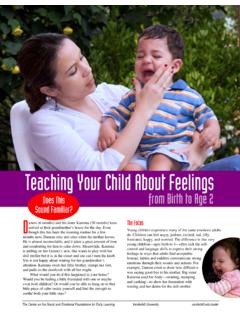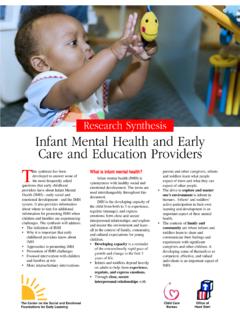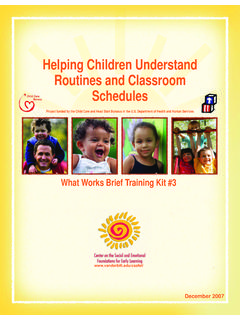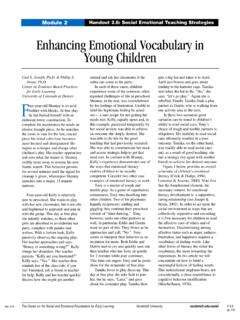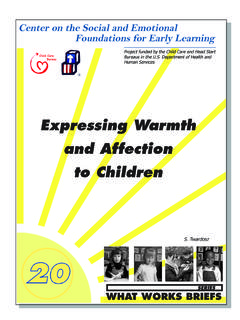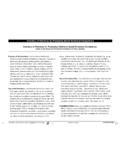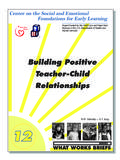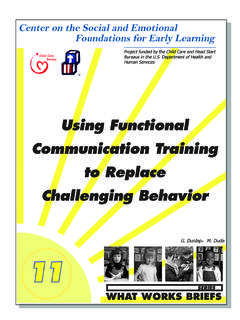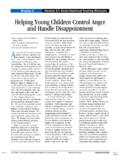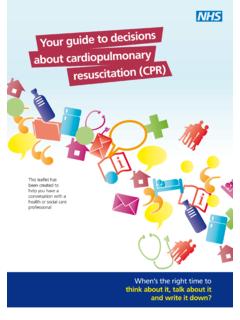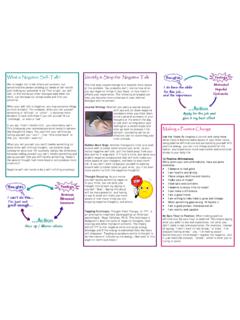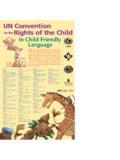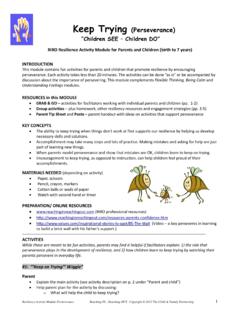Transcription of Book Nook - Vanderbilt University
1 Mouse Was MadBy Linda UrbanHarcourt Children s BooksMouse Was Mad follows a young mouse through the forest as hesearches for the perfect way to show that he is feeling mad. As Mousetries different ways to express himself, other animals in the forest try toteach him the right way to be mad. Hare explains how to hop, Bearshows how to stomp, Bobcat tries to teach a scream, and Hedgehogdemonstrates the perfect way to roll. But none of these are right forMouse! He becomes more and more upset until finally, he discovers hisvery own way to be mad. Mouse Was Mad provides a great opportunityto talk about feeling mad and how we express that feeling. (Ages 2-5)Examples of activities that can be used while reading Mouse Was Madand throughout the day topromote social and emotional development: Before reading Mouse Was Mad,ask the children what they do when they are feeling mad.
2 Tell thechildren what you do when you are feeling mad. Explain that everyone has a different way to showthat they are feeling mad and that there isn t a right or wrong way. Some of us are quiet, some shoutor cry. Some want to be alone and some want to tell someone else. Tell the children that you aregoing to read a story about a Mouse who was mad. Ask the children what they think a mouse mightdo to show that he was feeling mad. Then read the story to find out! Ask the children how they would know if someone was mad. What would someone s face look likeif they were feeling mad? Would they smile or frown? Show some pictures of children showingdifferent emotions (make sure some of the faces look angry or mad). Ask how they think thechildren in the pictures are feeling and why they think that (point out facial expressions). As youread the book , ask the children to look closely at the illustrations of Mouse.
3 What can they see thatshows that he is feeling mad? Children might notice that mouse has an angry frown on his face, orthat his hands are in fists, or that he is hopping, stomping, screaming, or rolling. Ask children tothink of what other animals might do to show they were mad. What would a lion do? Or a horse?Talk about different ways that people show that they are mad. Ask, When Mouse was mad, hestomped his feet. Is that something a person might do if they were feeling mad? What else mightthey do? Explain to the children that it is okay to feel mad. Even though we all feel mad sometimes, there aremany ways to express feeling mad and to help the feeling go away. Remind the children how, at theend of the story, Mouse finally just stood still and then he realized that he wasn t mad any more!Ask the children to share what they do to help a mad feeling go away.
4 Some might take a break fromwhat they are doing or tell someone else how they feel. After getting ideas from the children, explainthat you are going to teach them a special way to calm down when they feel mad. Teach the TurtleTechnique (See the Tucker Turtle Takes Time to Tuck and think in the Scripted Stories for SocialSituations section of the CSEFEL website ). By using this technique, book NookUsing Books to Support Social Emotional DevelopmentThe Center on the Social and Emotional Foundations for Early Learning Child Care BureauOffice ofHead Start book Nookchildren will learn to keep their hands, feet, and voices to themselves. They will know to take threedeep breaths to calm down, and to think of a good solution once they are calm. The website alsoincludes a list of potential solutions that children can use to help them think of good solutions.
5 Postthe turtle technique in your classroom and talk about it often so children will know what to dowhen they feel the same book for several days in a row is a great way to provide opportunities for infants,toddlers, and preschoolers to develop a sense of competence and confidence, which is an importantpart of social and emotional development. They become able to turn pages, point at and labelpictures, talk about the story, predict what will happen next, learn new vocabulary words, talk abouttheir own experiences in relation to the story and even make up their own story! Try reading MouseWas Madfor several days in a row and use some of the ideas, activities, and teaching opportunitieslisted below to enhance social and emotional :Before you go outside to play, review some of the things that Mouse did to tryto show that he was mad (stomp, hop, roll, etc.)
6 Explain to the children that you are going to play anoutdoor game using all of the actions fromMouse Was Mad. When you get outside practice each ofthe actions together so that everyone knows how to do them. Then play a Simon Says type gamethat incorporates the actions along with direction following skills and numbers/colors/letters. You cansay things like, If you are wearing red, hop like Hare two times or, If you have the letter M inyour name, roll once like Hedgehog. You can make the instructions as simple or as complex asneeded depending on the group of children. At the end, everyone can practice the Turtle Techniquetogether by standing very still (just like Mouse did) and taking three deep breaths. Use a parachute orgreen sheet as Tucker turtle s shell so everyone can go under the sheet (adults can hold the sheet) topractice taking three deep breaths.
7 Remind children that they can do this when they are feeling madto help themselves calm down. Art:Reread the first part of the story where Mouse falls into a mucky mud puddle every time he triesto follow the other animal s advice on how to be mad. Ask children how they would feel if they fellinto a big mud puddle. Would it make them mad? Tell the children that they can make their own mucky mud puddle finger paintings. Give the children smocks and large sheets of paper. Providevarious shades of brown, black, and grey washable finger paints that will look like the mucky mudpuddles from the story. If some children don t want to get paint on their hands, they can use a brushor other tools (plastic silverware, old toy cars, leaves) to make designs with the paint. Then dive inand have fun!Dramatic Play: Help children act out the Mouse Was Mad story. They can pretend that they areeither Mouse or the other animals in the forest.
8 Talk about how the other animals in Mouse Was Madtried to tell Mouse what he was doing wrong when he stomped, hopped, rolled and screamed. Askthe children what they would do if they saw that a friend was mad. Would it be a good idea to tell thefriend what they were doing was wrong? Or, would it be better to help him calm down and think of agood solution? Children can practice being Mouse and the other animals, but instead of trying to tellMouse what he is doing wrong, they can help mouse think of a solution. This is a great time topractice the turtle technique and coming up with good solutions! This could also be a group activityduring story book Nook was developed by Erin Olinger and Tweety Ma
